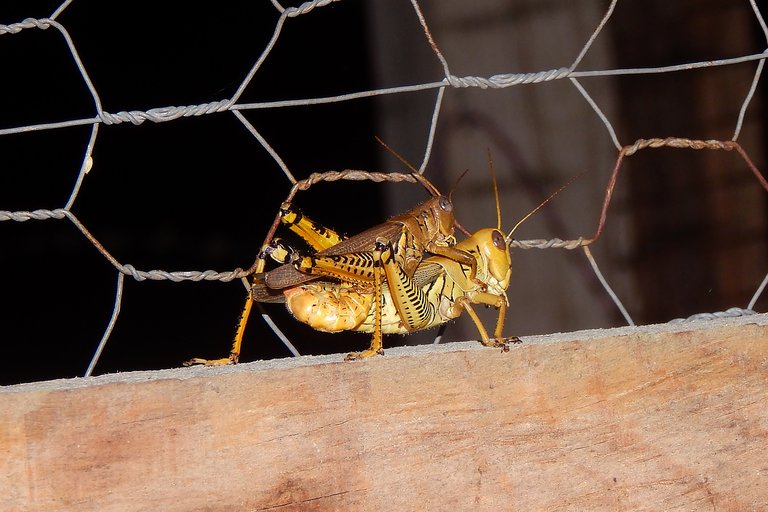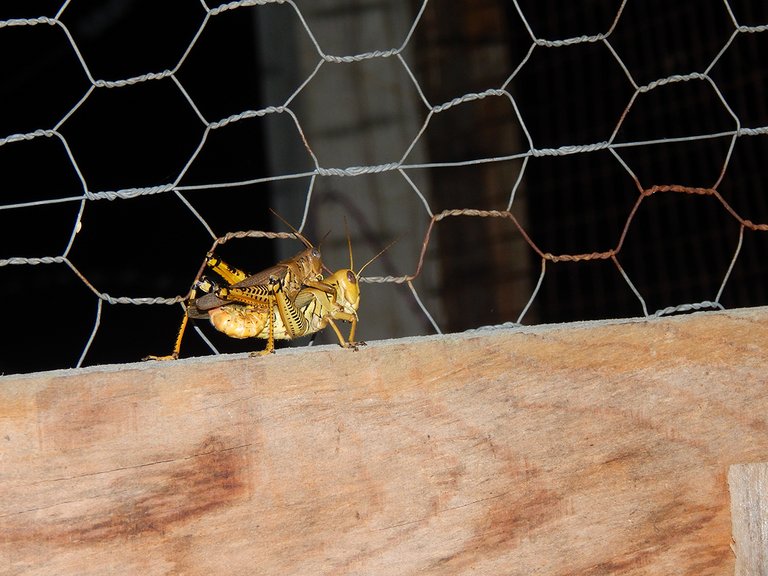She entered the county fair photo contest, and this photo won.
I think it deserves a look!

This is a zoomed-in picture to show a few details.

This is the photo that was entered and won Best of Show.

And this is the original composition before cropping and Photoshop editing by Dad
When my little girl came back from this photo shoot one evening, I knew immediately that this was some excellent photography.
It also turns out to be an interesting lesson in grasshopper physiology. And yes, they are indeed in the act.
Score one for nature! And for those of you who comment, please keep things simple. I would like to show this post to my young daughter.
Thank you!
These critters, that I call Lubbers, have many local names. Do you know any common names for them? They even have more than one scientific name.
Many people, including tropical fruit growers in Southern Florida, are afraid of them and think they will eat all the leaves of their plants. But after watching them year after year I noticed they do not each much. Sometimes you see dozens of them on a plant (but notice, are they really eating the leaves?) Probably not. You may as well see dozens of them on a fence or a rock -- they're not eating those, are they?
These are the biggest grasshoppers I've ever seen, but they don't fly as much as the smaller ones, they have very small wings.
I have only called these grasshoppers. I think there is a difference with a locust, which I think has knobbed antennae versus straight. I looked up this variety once, because this specimen wouldn't seem to be super common to my un-biological mind.
Apparently they are common in the South and South Eastern USA. However I grew up in the northern climes and always knew about grasshoppers (they spit tobacco juice) and fly into the side of your head when you walk across a field. But when I moved to Florida in 1980, I was astonished at the size of the lubbers, as people called them.
Wiki comes up with several local names including "diablo" and "black diablo," Devil's Horse, Graveyard Grasshopper and Giant Locust in Mississippi. And of course researchers are always messing with the scientific names too:
FROM WIKI: "It was long known as Romalea microptera before being moved to guttata. However, after new research, the remaining names (including guttata) have been marked as nomina oblita and microptera takes priority once more."
Tip of the hat to dad for enhancing the photo, but the original resolution was amazing.
Congratulations! This post has been upvoted from the communal account, @minnowsupport, by uruiamme from the Minnow Support Project. It's a witness project run by aggroed, ausbitbank, teamsteem, theprophet0, and someguy123. The goal is to help Steemit grow by supporting Minnows and creating a social network. Please find us in the Peace, Abundance, and Liberty Network (PALnet) Discord Channel. It's a completely public and open space to all members of the Steemit community who voluntarily choose to be there.
If you like what we're doing please upvote this comment so we can continue to build the community account that's supporting all members.
Wow. Nice
Thanks! Wow is what I said when I saw it, too.
bugs bonking. classic and educational.
@uruiamme best
Wow! Excellent detail.
Yes, and it wasn't some spectacular camera... the flash caught everything just right. No red compound eye, either!
Nice shot!
Thanks! Unbelievable. She likes to borrow my good camera... then came in with this. She had a number of other compositions, but I am sharing this because it was somewhat amazing.
wow congratulations young junior photographer :)
Thanks! I will tell her.
congrats